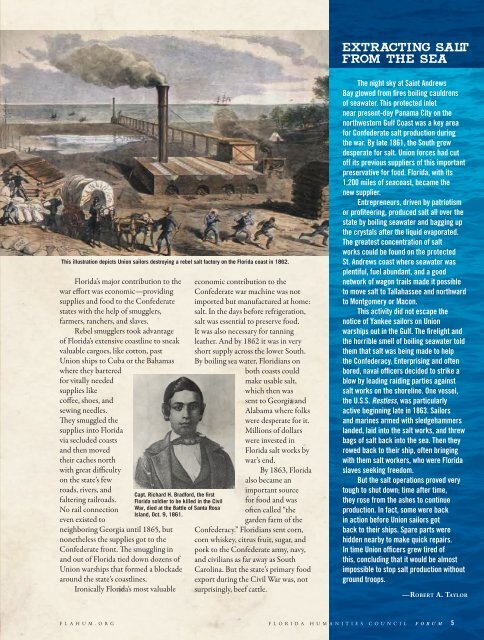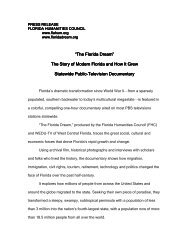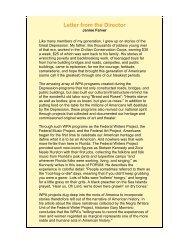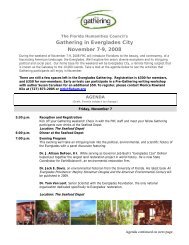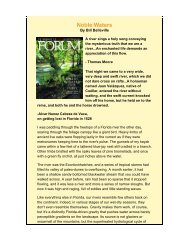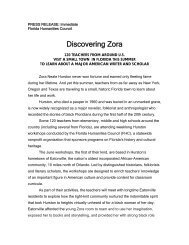when florida “Opened up the gates of hell” - Florida Humanities ...
when florida “Opened up the gates of hell” - Florida Humanities ...
when florida “Opened up the gates of hell” - Florida Humanities ...
Create successful ePaper yourself
Turn your PDF publications into a flip-book with our unique Google optimized e-Paper software.
This illustration depicts Union sailors destroying a rebel salt factory on <strong>the</strong> <strong>Florida</strong> coast in 1862.<br />
<strong>Florida</strong>’s major contribution to <strong>the</strong><br />
war effort was economic—providing<br />
s<strong>up</strong>plies and food to <strong>the</strong> Confederate<br />
states with <strong>the</strong> help <strong>of</strong> smugglers,<br />
farmers, ranchers, and slaves.<br />
Rebel smugglers took advantage<br />
<strong>of</strong> <strong>Florida</strong>’s extensive coastline to sneak<br />
valuable cargoes, like cotton, past<br />
Union ships to Cuba or <strong>the</strong> Bahamas<br />
where <strong>the</strong>y bartered<br />
for vitally needed<br />
s<strong>up</strong>plies like<br />
c<strong>of</strong>fee, shoes, and<br />
sewing needles.<br />
They smuggled <strong>the</strong><br />
s<strong>up</strong>plies into <strong>Florida</strong><br />
via secluded coasts<br />
and <strong>the</strong>n moved<br />
<strong>the</strong>ir caches north<br />
with great difficulty<br />
on <strong>the</strong> state’s few<br />
roads, rivers, and<br />
faltering railroads.<br />
No rail connection<br />
even existed to<br />
neighboring Georgia until 1865, but<br />
none<strong>the</strong>less <strong>the</strong> s<strong>up</strong>plies got to <strong>the</strong><br />
Confederate front. The smuggling in<br />
and out <strong>of</strong> <strong>Florida</strong> tied down dozens <strong>of</strong><br />
Union warships that formed a blockade<br />
around <strong>the</strong> state’s coastlines.<br />
Ironically <strong>Florida</strong>’s most valuable<br />
F L A H U M . O R G<br />
Capt. Richard H. Bradford, <strong>the</strong> first<br />
<strong>Florida</strong> soldier to be killed in <strong>the</strong> Civil<br />
War, died at <strong>the</strong> Battle <strong>of</strong> Santa Rosa<br />
Island, Oct. 9, 1861.<br />
economic contribution to <strong>the</strong><br />
Confederate war machine was not<br />
imported but manufactured at home:<br />
salt. In <strong>the</strong> days before refrigeration,<br />
salt was essential to preserve food.<br />
It was also necessary for tanning<br />
lea<strong>the</strong>r. And by 1862 it was in very<br />
short s<strong>up</strong>ply across <strong>the</strong> lower South.<br />
By boiling sea water, Floridians on<br />
both coasts could<br />
make usable salt,<br />
which <strong>the</strong>n was<br />
sent to Georgia and<br />
Alabama where folks<br />
were desperate for it.<br />
Millions <strong>of</strong> dollars<br />
were invested in<br />
<strong>Florida</strong> salt works by<br />
war’s end.<br />
By 1863, <strong>Florida</strong><br />
also became an<br />
important source<br />
for food and was<br />
<strong>of</strong>ten called “<strong>the</strong><br />
garden farm <strong>of</strong> <strong>the</strong><br />
Confederacy.” Floridians sent corn,<br />
corn whiskey, citrus fruit, sugar, and<br />
pork to <strong>the</strong> Confederate army, navy,<br />
and civilians as far away as South<br />
Carolina. But <strong>the</strong> state’s primary food<br />
export during <strong>the</strong> Civil War was, not<br />
surprisingly, beef cattle.<br />
extracting salt<br />
from <strong>the</strong> sea<br />
The night sky at Saint Andrews<br />
Bay glowed from fires boiling cauldrons<br />
<strong>of</strong> seawater. This protected inlet<br />
near present-day Panama City on <strong>the</strong><br />
northwestern Gulf Coast was a key area<br />
for Confederate salt production during<br />
<strong>the</strong> war. By late 1861, <strong>the</strong> South grew<br />
desperate for salt. Union forces had cut<br />
<strong>of</strong>f its previous s<strong>up</strong>pliers <strong>of</strong> this important<br />
preservative for food. <strong>Florida</strong>, with its<br />
1,200 miles <strong>of</strong> seacoast, became <strong>the</strong><br />
new s<strong>up</strong>plier.<br />
Entrepreneurs, driven by patriotism<br />
or pr<strong>of</strong>iteering, produced salt all over <strong>the</strong><br />
state by boiling seawater and bagging <strong>up</strong><br />
<strong>the</strong> crystals after <strong>the</strong> liquid evaporated.<br />
The greatest concentration <strong>of</strong> salt<br />
works could be found on <strong>the</strong> protected<br />
St. Andrews coast where seawater was<br />
plentiful, fuel abundant, and a good<br />
network <strong>of</strong> wagon trails made it possible<br />
to move salt to Tallahassee and northward<br />
to Montgomery or Macon.<br />
This activity did not escape <strong>the</strong><br />
notice <strong>of</strong> Yankee sailors on Union<br />
warships out in <strong>the</strong> Gulf. The firelight and<br />
<strong>the</strong> horrible smell <strong>of</strong> boiling seawater told<br />
<strong>the</strong>m that salt was being made to help<br />
<strong>the</strong> Confederacy. Enterprising and <strong>of</strong>ten<br />
bored, naval <strong>of</strong>ficers decided to strike a<br />
blow by leading raiding parties against<br />
salt works on <strong>the</strong> shoreline. One vessel,<br />
<strong>the</strong> U.S.S. Restless, was particularly<br />
active beginning late in 1863. Sailors<br />
and marines armed with sledgehammers<br />
landed, laid into <strong>the</strong> salt works, and threw<br />
bags <strong>of</strong> salt back into <strong>the</strong> sea. Then <strong>the</strong>y<br />
rowed back to <strong>the</strong>ir ship, <strong>of</strong>ten bringing<br />
with <strong>the</strong>m salt workers, who were <strong>Florida</strong><br />
slaves seeking freedom.<br />
But <strong>the</strong> salt operations proved very<br />
tough to shut down; time after time,<br />
<strong>the</strong>y rose from <strong>the</strong> ashes to continue<br />
production. In fact, some were back<br />
in action before Union sailors got<br />
back to <strong>the</strong>ir ships. Spare parts were<br />
hidden nearby to make quick repairs.<br />
In time Union <strong>of</strong>ficers grew tired <strong>of</strong><br />
this, concluding that it would be almost<br />
impossible to stop salt production without<br />
ground troops.<br />
—RoBeRt A. tAyloR<br />
F L O R I D A H U M A N I T I E S C O U N C I L F O R U M 5


